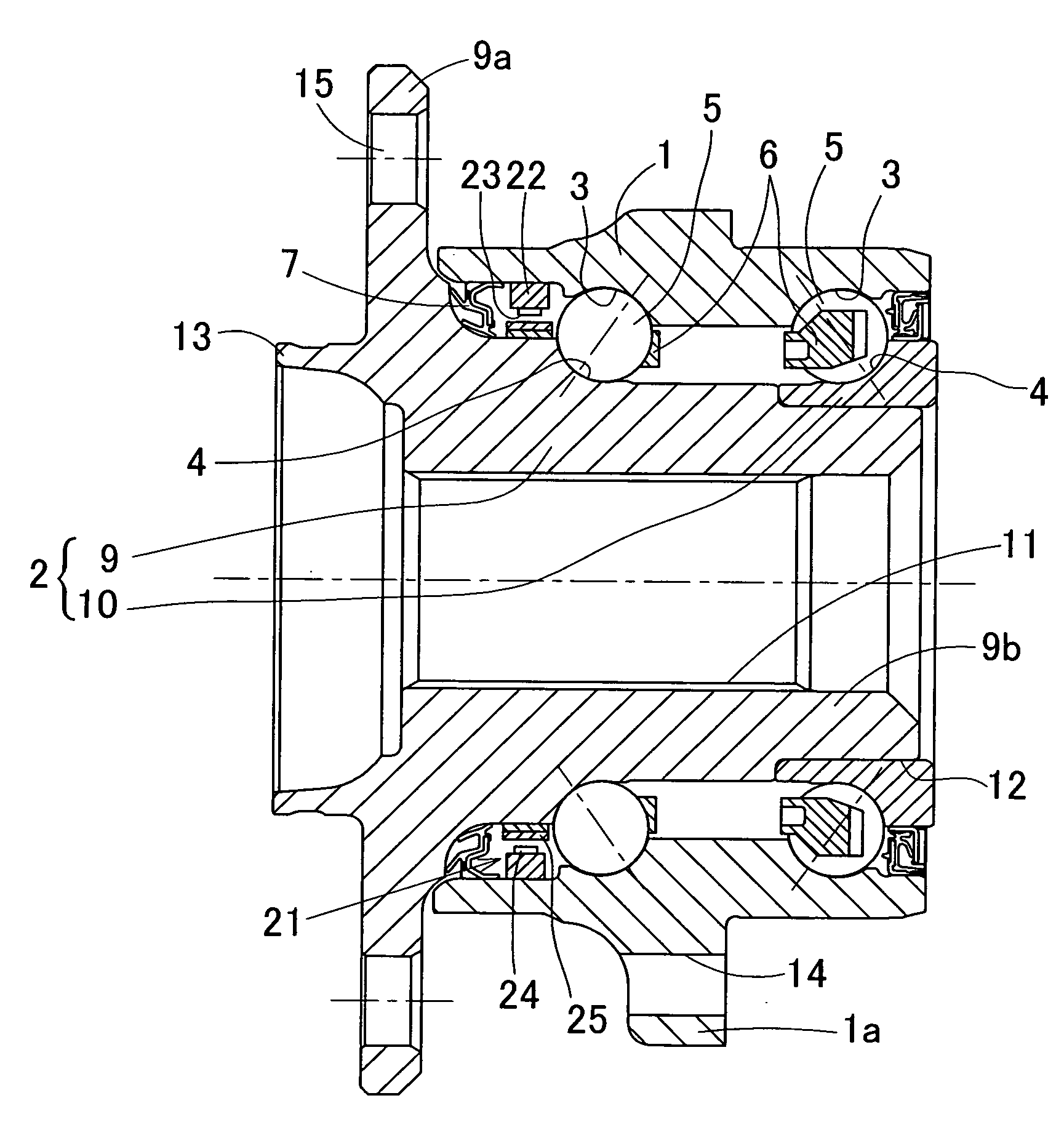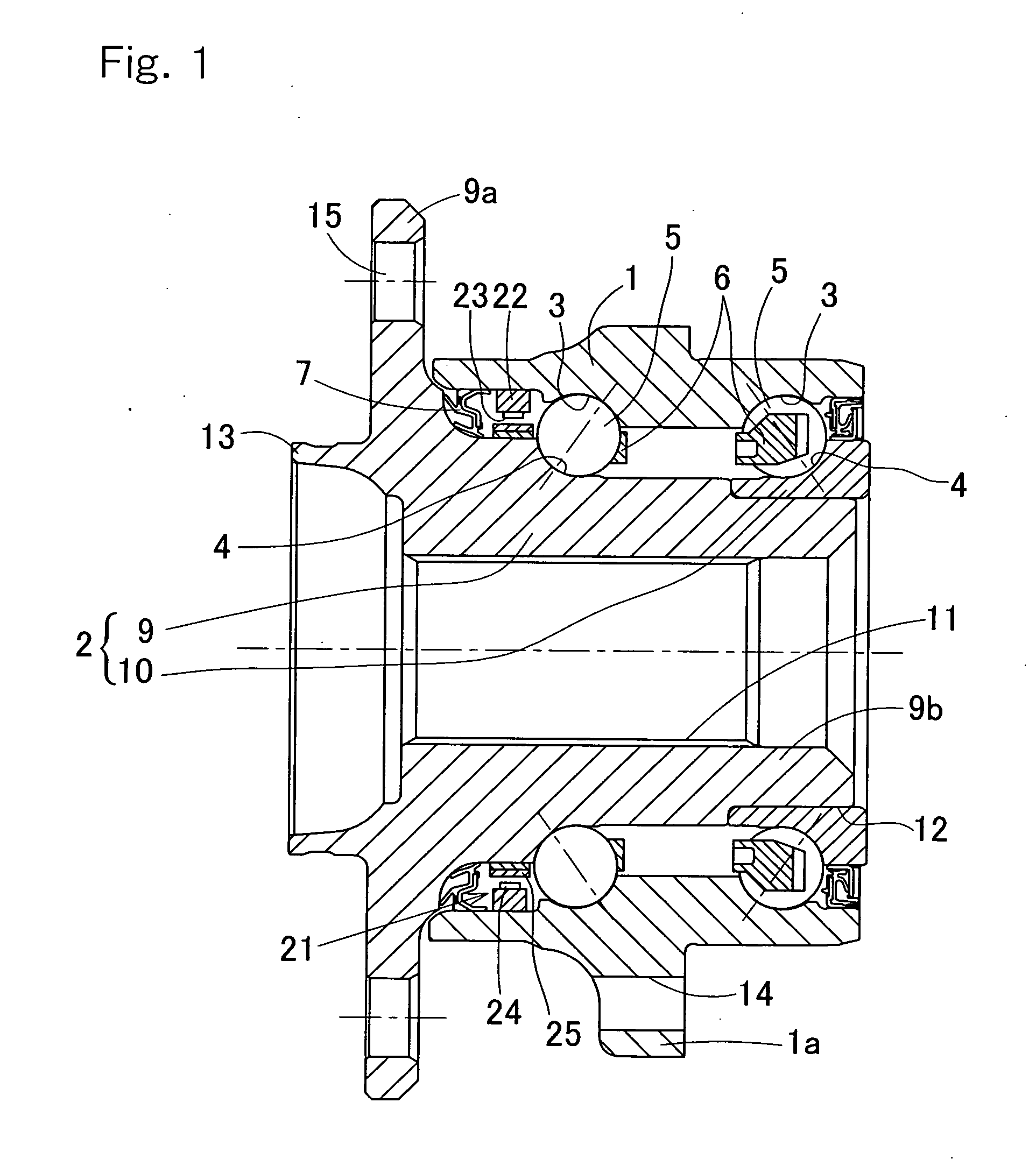Sensor-Equipped Wheel Support Bearing Assembly
a technology of bearings and bearings, which is applied in the direction of force sensors, instruments, transportation and packaging, etc., can solve the problems of deformation and strain on the sensor mounting members, and achieve the effects of reducing the cost of mass production, less sensitivity, and good sensitivity
- Summary
- Abstract
- Description
- Claims
- Application Information
AI Technical Summary
Benefits of technology
Problems solved by technology
Method used
Image
Examples
second embodiment
[0103]FIG. 9 to FIG. 11 show the present invention. This embodiment differs from the first embodiment in the structure of the ring member 22 constituting the sensor unit 21, but other structural features of the second embodiment are similar to those of the first embodiment, and thus same reference numerals are denoted for the common parts and the description thereof will be omitted.
[0104]The ring member 22 has, as represented by a sectional shape shown in FIG. 11, a contact ring portion (a first contact ring portion) 22a in contact with the inner peripheral surface of the outer member 1, a non-contact ring portion (a first non-contact ring portion) 22b not in contact with the inner peripheral surface of the outer member 1 and extending axially of the ring member 22, and a thick-walled portion (a second non-contact ring portion) 22c having a wall thickness greater than those of the first non-contact ring portion 22b and the first contact ring portion 22a, and positioned adjacent to t...
third embodiment
[0109]FIG. 12 to FIG. 14 show the present invention. This embodiment differs from the first and the second embodiments in the structure of the ring member 22 constituting the sensor unit 21, but other structural features of the third embodiment are similar to those of the first and the second embodiments, and thus same reference numerals are denoted for the common parts and the description thereof will be omitted.
[0110]As shown in FIG. 14, the second embodiment is similar to the second embodiment in that the ring member22 has the contact ring portion (the first contact ring portion) 22a in contact with the inner peripheral surface of the outer member 1 and the non-contact ring portion (the first non-contact ring portion) 22b not in contact with the inner peripheral surface of the outer member 1 and extending axially of the ring member 22, but is different from the second embodiment in that the ring member 22 further has a flange portion (a second non-contact ring portion) 22d protru...
sixth embodiment
[0127]FIG. 21 to FIG. 23 show the present invention. This embodiment differs from the first to the fifth embodiments in the structure of the sensor unit 21. The sensor unit 21 has the sensor mounting member 22 fitted to the surface of the outer member 1 at a portion in a circumferential direction thereof, the strain sensor 23 for measuring a strain on the sensor mounting member 22, which is affixed to the sensor mounting member 22, and the magnetic sensor 24 for detecting a rotation, which is of a type different from the strain sensor 23 and also affixed to the sensor mounting member 22. Other structural features of this embodiment are similar to those of the first to the fifth embodiments, and thus same reference numerals are denoted for the common parts and the description thereof will be omitted.
[0128]As shown in FIG. 23A, the sensor mounting member 22 has a substantially elongated arcuate shape corresponding to the shape of the inner peripheral surface of the outer member 1 and ...
PUM
 Login to View More
Login to View More Abstract
Description
Claims
Application Information
 Login to View More
Login to View More - R&D
- Intellectual Property
- Life Sciences
- Materials
- Tech Scout
- Unparalleled Data Quality
- Higher Quality Content
- 60% Fewer Hallucinations
Browse by: Latest US Patents, China's latest patents, Technical Efficacy Thesaurus, Application Domain, Technology Topic, Popular Technical Reports.
© 2025 PatSnap. All rights reserved.Legal|Privacy policy|Modern Slavery Act Transparency Statement|Sitemap|About US| Contact US: help@patsnap.com



